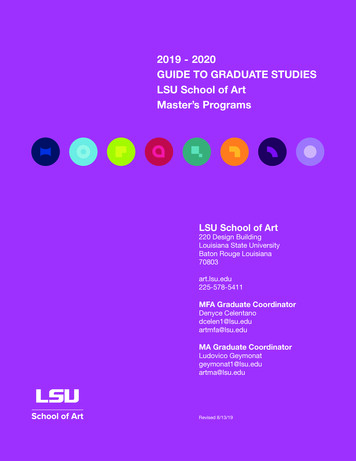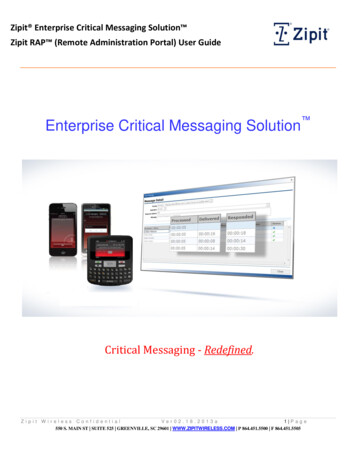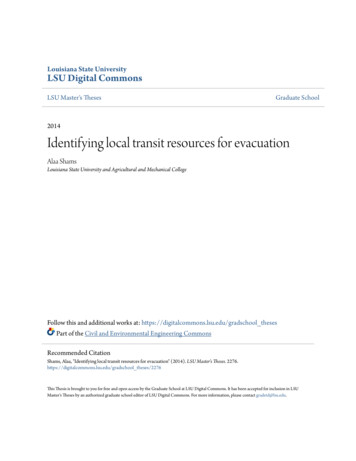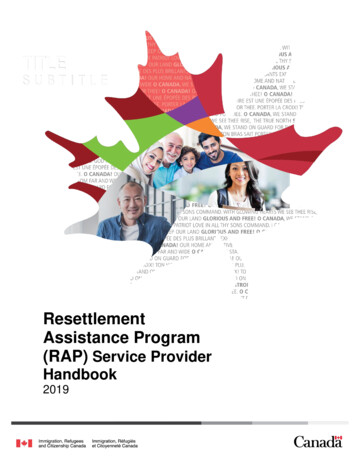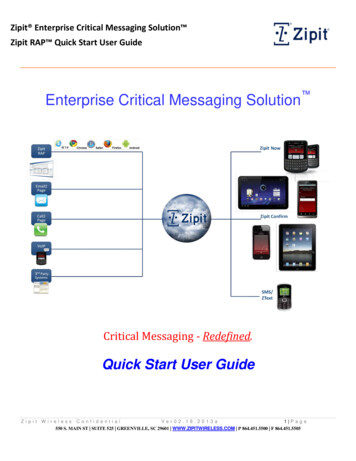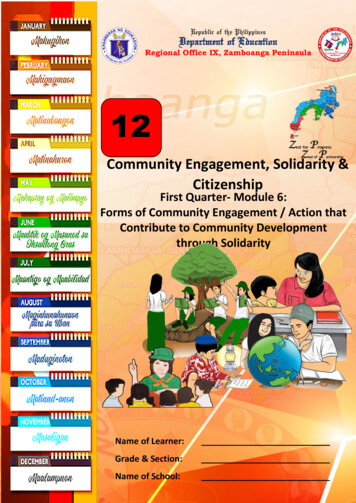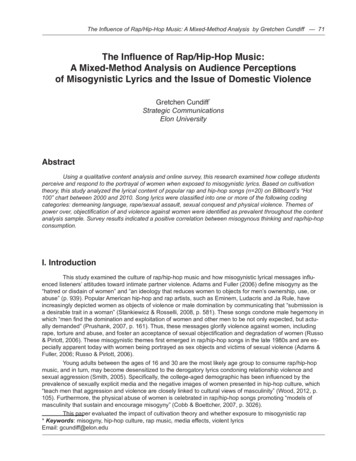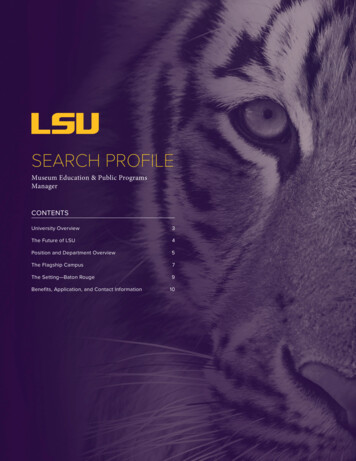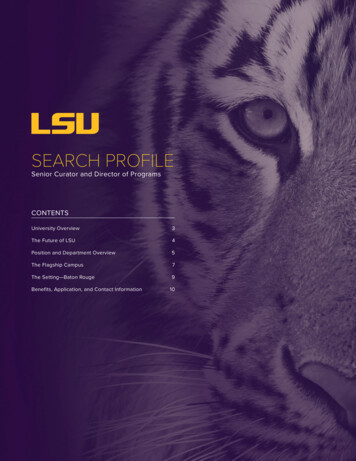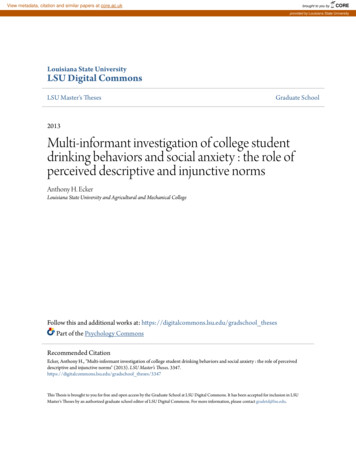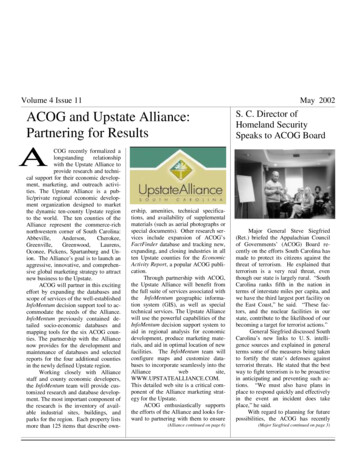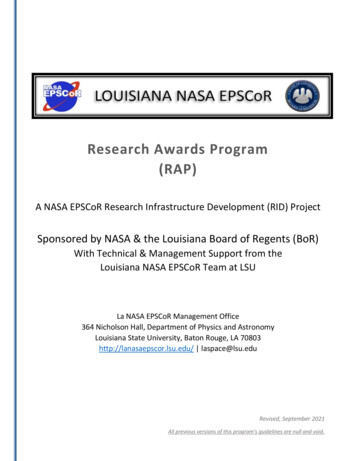
Transcription
Research Awards Program(RAP)A NASA EPSCoR Research Infrastructure Development (RID) ProjectSponsored by NASA & the Louisiana Board of Regents (BoR)With Technical & Management Support from theLouisiana NASA EPSCoR Team at LSULa NASA EPSCoR Management Office364 Nicholson Hall, Department of Physics and AstronomyLouisiana State University, Baton Rouge, LA 70803http://lanasaepscor.lsu.edu/ laspace@lsu.eduRevised, September 2021All previous versions of this program’s guidelines are null and void.
RAP Program Summary PageAbout the RAPThe RAP sub-program is designed for those researchers who have made a NASA contact and are readyto take the next step of initiating a small project. This could involve almost any type of NASA relevantwork, such as utilizing a specific NASA facility, employing NASA expertise, or building upon previousNASA work (akin to technology/knowledge transfer) or working with a NASA group on problems ofcommon interest. In all cases, the Louisiana researcher must have the support of a NASA researcherand include a plan for developing a research partnership, and the proposal must clearly state whichMission Directorate this project aligns with. The goal here is to develop larger, longer-lastingcollaborative projects that can transition to the next level.RAP Projects are designed to provide seed grants for R&D that have a demonstrated tie-in to a NASApriority. Projects are open to any area relevant to NASA's mission. Each project proposal must include aNASA Collaboration Development Plan that describes what effort has already been, and will be,undertaken to establish a partnership with one or more NASA researchers.An NOI is required in advance of proposal submission. Institutional sign-off is not required for theNOI. RAP awards will be issued for a 12-month period of performance. RAP-SIP awards are anticipatedto be in the 30K- 40K range. Proposing institutions are expected to provide a 50% total cost-match;e.g. if you request 40K in funding from the RAP program, you must commit at least 20K from yourinstitution. The project PI must be a faculty member at one of Louisiana’s institutions of highereducation.Proposal Submissions Submit a compliant RAP NOI to laspace@lsu.edu by 11:59 pm on Friday, December 3, 2021. Submit fully compliant, signed proposal via email as a fully searchable pdf document tolaspace@lsu.edu by 11:59 pm on Friday, January 7, 2022. Important Dates:o Proposal Release Date: Friday, October 1, 2021o NOI Due Date: Friday, December 3, 2021o Proposal Due Date: Friday, January 7, 2022o Anticipated Award Announcements: February 2022o Anticipated Period of Performance: April 1, 2022 – March 31, 2023La NASA EPSCoR BoR RAP Proposal Guidelines1
RAP Program GuidelinesIntroduction to the NASA EPSCoR RID ProgramThe NASA Established Program to Stimulate Competitive Research (EPSCoR) is administered throughNASA’s Office of STEM Engagement. The purpose of NASA EPSCoR is to strengthen the researchcapability of jurisdictions that have not in the past participated equitably in competitive federalresearch and development activities.The NASA EPSCoR Research Infrastructure Development (RID) program for 2019-2022 focuses onbuilding the core strength needed to develop competitive research and technology developmentmethods and activities for the solution of scientific and technical problems of importance to NASA asdefined by one or more of the four Mission Directorates and one or more of the ten NASA Centers(including JPL). RID programs will also contribute to the overall research infrastructure, science andtechnology capabilities, higher education, and/or economic development of the EPSCoR jurisdiction.An emphasis should be placed on developing a core expertise and robust research program capable ofsuccessfully competing for funds offered by NASA, industry, other federal agencies, and additionalexternal sources beyond the EPSCoR program.NASA 2018 Strategic PlanNASA’s 2018 strategic plan aligns the Agency’s future activities along three strategic themes of Discover,Explore, and Develop, as well as a fourth theme focused on the activities that will Enable the Agency’s mission. DISCOVER references NASA’s enduring purpose of scientific discovery.EXPLORE references NASA’s push to expand the boundaries of human presence in space.DEVELOP references NASA’s broad mandate to promote the technologies of tomorrow.ENABLE references the capabilities, workforce, and facilities that allow NASA to achieve its Mission.The complete plan can be downloaded here.NASA VisionTo discover and expand knowledge for the benefit of humanity.NASA MissionLead an innovative and sustainable program of exploration with commercial and international partners toenable human expansion across the solar system and bring new knowledge and opportunities back to Earth.Support the growth of the Nation’s economy in space and aeronautics, increase understanding of the universeand our place in it, work with industry to improve America’s aerospace technologies, and advance Americanleadership.NASA Office of STEM EngagementNASA’s journeys have propelled technological breakthroughs, pushed the frontiers of scientific research, andexpanded our understanding of the universe. These accomplishments, and those to come, share a commongenesis: education in science, technology, engineering, and math. NASA’s Office of STEM Engagement (OSTEM)delivers tools for young Americans and educators to learn and succeed. OSTEM seeks to:La NASA EPSCoR BoR RAP Proposal Guidelines2
Create unique opportunities for students and the public to contribute to NASA’s work in exploration and discovery. Build a diverse future STEM workforce by engaging students in authentic learning experiences with NASA people,content, and facilities. Strengthen public understanding by enabling powerful connections to NASA’s mission and work.To achieve these goals, NASA’s Office of STEM Engagement strives to increase K-12 involvement in NASAprojects, enhance higher education, support underrepresented communities, strengthen online education, andboost NASA's contribution to informal education. The intended outcome is a generation prepared to code,calculate, design, and discover its way to a new era of American innovation.The Aerospace Research and Career Development (ARCD) EPSCoR program strengthens the research capabilitiesof the nation’s colleges and universities. The EPSCoR research conducted contributes to the research needs ofNASA’s mission directorates and advances the nation’s scientific and technology innovation agenda as well asthe jurisdiction’s aerospace research and development priorities.NASA Mission DirectoratesResearch and technology priorities are aligned with one or more of NASA’s Mission Directorates:The Science Mission Directorate (SMD) expands the frontiers of Earth science, heliophysics, planetary science,and astrophysics. Using robotic observatories, explorer craft, ground-based instruments, and a peer-reviewedportfolio of sponsored research, SMD seeks knowledge about our solar system, the farthest reaches of spaceand time, and our changing Earth.The Aeronautics Research Mission Directorate (ARMD) transforms aviation with research to dramaticallyreduce the environmental impact of flight, and improves aircraft and operations efficiency while maintainingsafety in increasingly crowded skies. ARMD also generates innovative aviation concepts, tools, and technologiesfor development and maturation by the aviation community.The Space Technology Mission Directorate (STMD) pursues transformational technologies that have highpotential for offsetting future mission risk, reducing cost, and advancing existing capabilities. STMD uses meritbased competition to conduct research and technology development, demonstration, and infusion of thesetechnologies into NASA’s missions and American industry. This mission directorate is being refocused as a newExploration Research & Technology (ER&T) organization to support exploration as a primary customer.The Human Exploration and Operations Mission Directorate (HEOMD) leads human exploration in and beyondlow Earth orbit by developing new transportation systems and performing scientific research to enablesustained and affordable human life outside of Earth. HEOMD also manages space communication andnavigation services for the Agency and its international partners.Programs supported by La NASA EPSCoR must support the NASA organization, align with the NASAStrategic Plan, and support the goals of one or more directorates, NASA centers, and the Office ofSTEM Engagement. See Appendix A for a current list of areas of interest listed by MD and Center.La NASA EPSCoR BoR RAP Proposal Guidelines3
NASA EPSCoR Research LiaisonsThere is a NASA EPSCoR Research Liaison within each Mission Directorate and at each Center. Theseliaisons can assist with activities ranging from site visits for establishing collaborations to resolvingissues after the award. Technical and scientific questions about research opportunities in thisannouncement may be directed to the appropriate contact below. Discussions of research with theappropriate NASA EPSCoR Research Liaison (MD, Center, or JPL) personnel are strongly encouraged.NASA Mission Directorate ContactsThe Aeronautics Research Mission Directorate (ARMD), POC: Karen Rugg, Lead, Communications &Education, Phone: (202) 358-2197 karen.l.rugg@nasa.govHuman Exploration and Operations Mission Directorate (HEOMD), POC: Bradley Carpenter, Space Lifeand Physical Sciences Research & Applications Division, Phone: (202) 358-0826, BCarpenter@nasa.govScience Mission Directorate (SMD), POC: Kristen Erickson, Director, Science Engagement &Partnerships, Phone: (202) 358-1017, kristen.erickson@nasa.govSpace Technology Mission Directorate (STMD), POC: Damian Taylor, Directorate Liaison, SBIR andSTTIR Mission, Phone: (202) 358-1432, damian.taylor@nasa.govNASA EPSCoR Center LiaisonsAmes Research Center, Brenda CollinsChief, Education and Public OutreachPhone: (650) 604-3540brenda.j.collins@nasa.govArmstrong Flight Research Center, Dave BergerUniversity Affairs OfficerPhone: (661) 276-5712dave.e.berger@nasa.govGoddard Space Flight Center, James HarringtonSTEM Engagement SpecialistPhone: (301) 286-4063james.l.harrington@nasa.govJet Propulsion Laboratory, Linda Rodgers or PetraKneisslUniversity Programs AdministratorsLinda - Phone: (818) 354-3274Linda.L.Rodgers@jpl.nasa.govPetra – Phone: (818) on Space Center, Kamlesh LullaDirector, University Research Collaborations andPartnership OfficePhone: (281) 483-3065Kamlesh.P.Lulla@nasa.govLa NASA EPSCoR BoR RAP Proposal GuidelinesKennedy Space Center, Jeffrey A. KohlerTechnology Transfer OfficePhone: (321) 867-2462jeffrey.a.kohler@nasa.govLangley Research Center, Kim BrushLaRC OSTEM Integration ManagerPhone: (757) 864-6454kimberly.m.brush@nasa.govGlenn Research Center, Mark David Kankam, Ph.D.University Affairs OfficerDir. of NASA Space & Aeronautics Academy atGlenn, Phone: (216) 433-6143Mark.D.Kankam@nasa.govMarshall Space Flight Center, Frank SixUniversity Affairs OfficerOffice of Academic Affairs (HS30)Phone: (256) 961-0678Norman.F.Six@nasa.govStennis Space Center, Mitch KrellUniversity Affairs OfficerPhone: (228) 688-1821Mitch.Krell@nasa.gov4
NASA EPSCoR RID Program in LouisianaThe Louisiana Board of Regents (BoR) has received an EPSCoR Research Infrastructure Development(RID) award, “New Development for Louisiana Aerospace Research,” from the NASA EPSCoR program.Moving a jurisdiction forward in competitiveness is the foundational goal of all EPSCoR programs and ismeasured by a jurisdiction’s rank in its percentage of federal R&D funds received over a three-yearperiod. Louisiana’s success with EPSCoR can be seen by looking at the state’s rankings over time –moving from the bottom to the mid-point on the EPSCoR list. Aerospace has accounted for much of ourgrowth with expertise developed in areas ranging from smart materials to air traffic management,from additive manufacturing to astrophysics. But the work is far from completed. We need to buildupon what has been accomplished and move forward into increased competitiveness.Achieving this goal requires a number of plans and actions: (a) expanding university educationalopportunities, (b) enhancing research infrastructure, (c) fostering R & D capabilities, and (d) capitalizingupon the resultant intellectual property. NASA EPSCoR provides university students and facultyexposure to and involvement in the Aerospace research enterprise, improves faculty researchcapabilities (both at a given institution and between institutions), enhances research facilities andinfrastructure, and opens opportunities for faculty (particularly junior faculty), post-doctoralresearchers, and students to engage in meaningful Aerospace R&D all with the goal of graduating fromthe EPSCoR program designation. The Research Infrastructure Development (RID) component of NASAEPSCoR is of critical importance to prepare Louisiana’s researchers to become involved in largerprojects which can be proposed as NASA EPSCoR Research Implementation Projects or proposed toNASA opportunities issued by the directorates. Thus, the overall Goal for the NASA EPSCoR RID is toElevate the Competitiveness of the State's researchers in Aerospace Science and TechnologyDevelopment.Research Award Program (RAP)The RAP sub-program provides seed funding for Louisiana researchers working on a NASA-relatedresearch project with the explicit support of a NASA researcher. This could involve almost any type ofNASA relevant project, such as utilizing a specific NASA facility, employing NASA expertise, buildingupon previous NASA work (akin to technology/knowledge transfer), or working with a NASA group onproblems of common interest. In all cases, the Louisiana researcher must 1) have the support of aNASA researcher and include a plan for developing a research partnership and 2) provide evidence ofdirect alignment with at least one NASA Mission Directorate. The goal here is to develop larger,longer-lasting collaborative projects that can transition to the next level.RAP projects are designed to provide seed grants for R&D projects to be conducted at a singleLouisiana institution that have a demonstrated tie-in to a NASA priority. Projects are open to any arearelevant to NASA's mission. Each project proposal must include a NASA Collaboration DevelopmentPlan that describes what effort has already been, and what will be, undertaken to establish aLa NASA EPSCoR BoR RAP Proposal Guidelines5
partnership with one or more NASA researchers. Proposal evaluation criteria will include whether thePI has already established a NASA link as evidenced by a letter or e-mail from one or more NASAsupporters indicating their interest in the project and willingness to host a visit by the PI or the PI team.During the period of the award (nominally 12 months), the research team should plan to make one ormore trips to the NASA facility to interact with the NASA researcher who supports the project. Theproject PI must be a faculty member at one of Louisiana’s institutions of higher education. Postdoctoral associates, graduate students, and undergraduate student researchers should be involved asneeded. RAP Projects may involve more than one faculty researcher, but only one faculty member canserve as the PI.These seed grants from NASA EPSCoR are not just research grants. Excellent research must beperformed, but the project should also be designed to (a) increase research capacity andcompetitiveness and (b) be scalable to a team approach for a larger future endeavor. Evidence of theprobability of (a) and (b) must be presented in the proposal and addressed in the project report.EligibilityThe project PI must be a faculty member at one of Louisiana’s institutions of higher education. Postdoctoral associates, graduate students, and undergraduates should be involved as needed.The RAP sub-program is designed to provide seed grants to LA researchers for R & D that has ademonstrated tie-in to a NASA center. Projects must involve Research or Technology and are open toany area relevant to NASA. Proposals must explicitly link the proposed project to a research prioritywithin one of NASA’s four Mission Directorates. A letter/email of interest from a NASA researcherwhich shows support for the project, a willingness to host a visit from the PI/team and recognizespotential for future collaborations must be included. During the period of the award (nominally 12months), the researcher must make one, or more, trips to the NASA center to interact and/or workwith the NASA researcher who has shown interest in the project. Contact info for Mission DirectorateLeads and University Affairs Officers at the various NASA centers are included earlier in theseguidelines.NASA Collaboration Development PlanEach project proposal must include a NASA Collaboration Development Plan that describes what efforthas already been, and will be, undertaken to establish a partnership with one or more NASAresearchers. Proposal evaluation criteria will include whether the PI has already established a NASAlink as evidenced by a letter or e-mail from one or more NASA supporters indicating their interest inthe project and willingness to host a visit by the PI or the PI team. See Appendix A for a current list ofareas of interest listed by NASA MD and Center.Period of PerformanceRAP awards will be issued for a 12-month period of performance. No cost extensions (NCEs) forongoing projects may be considered if submitted to the La Board of Regents Sponsored ProgramsLa NASA EPSCoR BoR RAP Proposal Guidelines6
office no later than 60 days before the initial project end-date. All NCE requests must include a multipage status report (similar to a final technical report) which addresses all accomplishments made todate on the project (including all publications, proposals, presentations, patents, etc), where theproject is in relation to the originally proposed end date, reasons why the project has been delayed,and a proposed plan for completing the project. This status report must also identify all participants onthe project and include demographics for each (students, post-docs, faculty, and staff). NCE optionswill be suspended when the parent award’s end date requires it.Award Funding AmountsRAP awards are anticipated to be in the 30K- 40K range. We anticipate funding 3 to 6 proposals thiscycle.Proposed CostsThis program is intended to improve research capability in Louisiana and, consequently, costs shouldprimarily support effort within the state. Direct labor costs will be allowed exclusively for faculty, staff,students, and visiting researchers at Louisiana institutions. Funding allocated outside of the state is notrecommended. If proposed, it should be minimal, must be well justified with compelling evidence thatsuch an investment would still offer substantial permanent improvement to Louisiana’s researchinfrastructure. A statement that funding to external sites would improve the probability of proposalselection would not be sufficient justification. Project costs should be documented in the proposal asnecessary to meet the project goals and objectives. Reasonable costs include salary and wages forfaculty, research associates, and student researchers, travel to NASA centers for collaborationdevelopment meetings, and basic materials and supplies to conduct the research. This program is notdesigned to fully support a graduate student, and student tuition is not an allowable expense. Anyrebudgeting in excess of 20% requires advanced approval from the Board of Regents. Rebudgetrequests must be submitted in writing with a complete explanation as to why the funds could not bespent as proposed, why a rebudget is necessary, and how the newly structured budget will still meetthe spirit of the award. Rebudget requests must include the original budget and budget justificationsalong with the proposed revised budget and budget justification.Cost-ShareProposing institutions are expected to provide at least a 50% cost-match. For example, if you request 40,000 from the RAP program your institution must commit to 20,000 in cost-share. This is taken bythe reviewers as evidence of commitment on the part of the proposing institution(s). Such aninstitutional commitment in the form of re-assigned responsibilities is most significant since it allowsthe faculty member(s) sufficient time to participate in and manage the proposed research. Lack of suchtime calls into question the ability of the proposers to actually carry the project to a successfulconclusion. All cost sharing must be certified in the project final financial report.La NASA EPSCoR BoR RAP Proposal Guidelines7
Indirect (F&A) CostsRAP awards are typically funded with BoR cost-share funds and as such indirect (F&A) cost recoverywill be allowed at the BoR rate, i.e. 25% of salaries, wages, and fringe benefits. Unrecovered indirect isallowable (and recommended) cost sharing. The LaSPACE/La NASA EPSCoR program managementteam may choose to use any available NASA funds to support a RAP project, and in such instances theproposing institution agrees to retain the BoR indirect rate charges and cost restrictions, as originallyproposed.Award SubcontractAward funds will be provided by subcontract from the Board of Regents to the lead applicants’ collegeor university, which will assume responsibility for administering the funds according to standardprocedures. For PP awards, one institution must be the lead institution to which the award will begiven. This lead institution will subcontract with the partner institution.DiversityIt is a national priority to increase diversity in Science, Technology, Engineering, and Mathematics(STEM), from university students, faculty, and staff to industry employees. Traditionally, minoritygroups and women have been under-represented in the STEM disciplines as students and faculty aswell as in the workplace after graduation. All proposers are encouraged to help recruit diverseparticipants to their proposed projects.Animal UseAny project proposing the use of an animal model for validation must include a local IACUC approvalletter, fully signed, which specifies a validity period longer than the proposed project period. Failure toobtain the Institutional Animal Care and Use Committee’s approval in advance, is grounds for returningthe proposal unreviewed. Attach the IACUC material as an additional appendix.Human SubjectsProjects that involve human subjects are not acceptable for this program.CertificationsWhen preparing a proposal that requires institutional certification, waiver, or approval the proposerswill need to address applicable compliance issues in advance. All necessary internal approvals fromthe lead and collaborator institutions must be secured and documented in writing. A letter (seesample in the attachments section of these guidelines) signed by the authorized organizationrepresentative certifying that all reviews and waivers relevant to the proposal have been completedmust be submitted to laspace@lsu.edu no later than 30 calendar days after the proposal due date.Even through extra time is allowed to submit the commitment document, the letter is considered to bepart of the proposal and will be included as an appendix in the subaward contract from the Board ofRegents. Failure to provide this commitment in the approved time frame may result in disqualificationand selection of alternate proposals.La NASA EPSCoR BoR RAP Proposal Guidelines8
Public Nature of ApplicationsOnce an application is received, it becomes public record. Although the staff will not disseminateapplications to individuals other than to reviewers, applicants should be aware that, if a request forinformation is made by the public (e.g., the news media), a copy of the application, by law, must beprovided.Disclosure of InformationAll La NASA EPSCoR programs must conform to applicable Federal, State, and NASA Agency regulationsand stipulations. This includes annual reporting of award participant information to both the LouisianaBoard of Regents and NASA. Part of this information will include both directory information such asname, address, telephone number, date of birth, and demographic information such as gender,ethnicity, and race for all award participants including faculty, staff, and students. Further, outreachincludes public dissemination of its supported programs through The Spaceporter Newsletter, the LaNASA EPSCoR website (http://laNASAepscor.lsu.edu/), as well as papers and/or presentations at SpaceGrant or related Education & Public Outreach conferences. The contents of award reports, includingparticipant names, titles, institution, project summaries, results or conclusions and images, might beincluded in such public outreach articles. It is not intended that these public articles will disclosedirectory or demographic information except as aggregated statistical data.Final DeliverablesAt the end of the project, two final reports are required: the Final Technical Report and the FinalFinancial Report. These reports are due within 30 days after the subcontract expiration date.The Final Technical Report will be a multi-page write-up that is suitable for transmission to NASA andBoR. This report should describe the activities undertaken, the participants, and your assessment, asPrincipal Investigator, of the success of the venture, the impact that it had (or will have), any follow-onproposals in preparation/submitted and any further plans for a continuation of this or similar projects.Please also include a full bibliography. Copies of reports, presentations, publications, follow-onproposals, patent related material, technology transfer, or publicity may be submitted as required inthe report narrative. These items should contain citations acknowledging NASA EPSCoR/BoR support.This report shall be submitted to the Board of Regents (jessica.patton@laregents.edu) and the LANASA EPSCoR/ LaSPACE office (laspace@lsu.edu) via email.The Final Financial Report is an official report that shows the final expenditure of the funds andcertifies the cost sharing. This report is to be submitted to the Board of Regents by your university'sfinancial office using the BoR electronic reporting system.Additional instructions for reporting are given in the sub-award document.La NASA EPSCoR BoR RAP Proposal Guidelines9
Evaluation CriteriaA panel of external reviewers will rate all of the proposals on the following criteria. (25%) Scientific & Technical Merit (15%) Relevance to space/aerospace fields (10%) Relevance to on-going research project/priority at a NASA Mission Directorate/Center (15%) Potential for additional funding at more competitive/higher levels (10%) Evidence of NASA enthusiasm based on the letter of interest (15%) Demonstrated competency of the proposed team to complete the scope of work (10%) Appropriateness of the budget to complete the work; sufficient university investmentLa NASA EPSCoR BoR RAP Proposal Guidelines10
RAP Proposal Format & SubmittalRAP proposals should be submitted as fully searchable pdf documents via email to laspace@lsu.edu.A RAP proposal must include the following completed sections in the order presented: RAP Cover Page Proposed Project Summary Page Current & Pending Support Form Proposal Narrative (not to exceed 10 pages, including figures and tables, no smaller than 11point font & one inch margins)1) Introduction (overview of the scope of work for this proposal, include mention of the NASA missiondirectorate and any major ongoing NASA research projects this work is relevant to).2) Background (provide a bigger picture of how the proposed work fits into your overall research plans andthe field of study at large).3) Research Objectives (clearly identify all science and technical objectives for this proposal).4) Relevance to NASA and NASA Mission Directorates/Centers (identify all the current and potentialapplications/relevance to NASA, including future scalability of this project and where a larger scaleproject would fit in. Explicitly identify the mission directorate to which this project aligns with details onthe related research priorities of said MDs). See Appendix A for a current list of areas of interest listed byMD and Center.5) Implementation Strategy and Milestone Schedule (detail exactly what deliverables are expected, when,and by whom; clearly reference any partner institutions if this is a PP).6) NASA Collaboration Development Plan (map out any contact you have had thus far with a reasonableplan for development over the course of this project, including number of meetings in person or viaphone/web technology; be sure to identify what you will get from NASA and what NASA will get fromyou over the period of the award).7) Management Plan (lay out a hierarchy of individuals/institutions working on the project, a recruitmentplan for team members not yet identified, and methods for tracking and reporting progress throughoutthe project; partnership proposals must clearly divide tasks and lay out a clear plan for managing workat multiple institutions).8) Anticipated Outcomes/Plans for Future Endeavors/Future Collaborations with NASA (include plans forpublications, conferences, funding opportunities, and full-scale collaborations).9) Contribution to Diversity (explain how your research team contributes to diversity and what efforts youwill take to recruit additional team members from diverse backgrounds) References Cited within the proposal Budget Section: Each participating institution must have its own completed Budget Formfollowed by a narrative explanation of all costs listed on its form. Explanations are required forboth requested funds and proposed cost-shares. Letter(s) of Interest from a NASA Researcher Short Vita for Principal Investigator Letter Ce
Submit a compliant RAP NOI to laspace@lsu.edu by 11:59 pm on Friday, December 3, 2021. Submit fully compliant, signed proposal via email as a fully searchable pdf document to laspace@lsu.edu by 11:59 pm on Friday, January 7, 2022. Important Dates: o Proposal Release Date: Friday, October 1, 2021 o NOI Due Date: Friday, December 3, 2021
